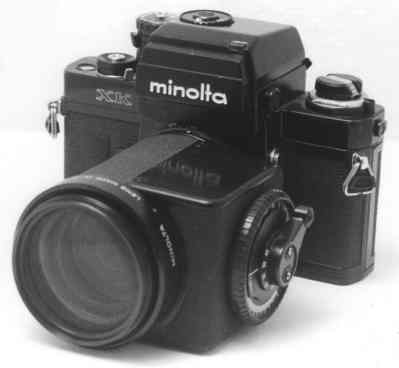
XK
(1972) From 1966 to 1971, the only SLR cameras that Minolta marketed were
the incredible SRT101 and the more economical
SR-1s & SRT100. These
cameras sold well, but Minolta knew that they had to make improvements --
and fast. Specifically, sales of rangefinder cameras were doing extremely
well, compared to SLR cameras, primarily because the rangefinder cameras
offered automatic exposure control, while SLR cameras lacked this feature.
In short, the rangefinder cameras were smaller, lighter, cheaper and
much easier for photographers to use. Just as important, Minolta knew
that other camera companies would soon figure out how to add TTL, automatic
exposure control to their SLR cameras.
Minolta saw an opening in the market and jumped on it. In late 1972,
they marketed the incredible XK camera. With such a new, advanced feature
as automatic exposure control, Minolta targeted the professional camera market,
at that time dominated by Nikon and Canon. The XK was the first
professional SLR camera with TTL, automatic exposure
control. "Revolutionary", was what the reviewers called it at
the time. And no wonder! The XK had through-the-lens (TTL) metering,
automatic diaphragm lenses, and automatic exposure control. But, it
had a lot more than that. Incredibly, it had shutter speeds from 16
seconds to 1/2000, with aperture-preferred, automatic exposure, metered-manual
and full manual settings, as well. The photographer now had incredible
options for exposure determination. The exposure could be set with
a hand-held meter, by matching the needles in the viewfinders (like on the
SRT101), or the camera could make the settings for
you.
The XK had a complete information viewfinder, but it was a big change from
that of the SRT101. In fact, it offered MORE
information than the SRT101 viewfinder -- which was considered by many to
be a complete information viewfinder. This was quite a challenge for Minolta
given the various exposure modes of the new XK. In the SRT101, the
manually-set shutter speed appears on a scale on the bottom of the screen
and two needles on the right-hand side of the screen match up by changing
the f-stop or shutter speed. With the XK, this approach wouldn't work
since the shutter speed could be set manually or autoamtically-set by the
camera. So Minolta devised a new viewfinder that incorporated the two
"scales". First, the XK shows the manually selected shutter speed --
just like the SRT101 -- but they now appear on a scale on the right-hand
side of the screen. The manually selected speed is indicated by a tab on
the scale. The big additiona is that the same shutter speed scale has
an additional needle that points to the recommended shutter speed (in manual
mode) or to the automatically-selected shutter speed (in auto mode). So the
single shutter speed scale shows the meter-recommended speed and the manually
selected speed on the same scale! This made manual use of the camera
so much easier, and is just one reason why so many Minolta users think that
the XK -- with the AE head -- is the best automatic camera that Minolta ever
made. In most of Minolta's subsequent automatic-exposure cameras, the manual
and automatic exposure indicators would not appear on the same scale.
But there was another big differecne with the XK viewfinder. The XK viewfinder
also shows the manually selected f-stop -- in a window on the top -- something
missing in the SRT101.
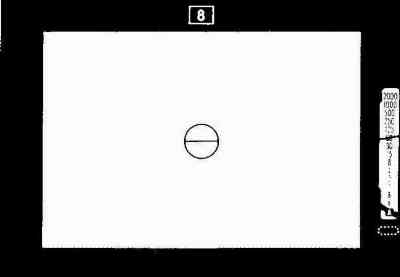
And on top of the new viewfinder (literally), the XK had interchangeable
heads with several choices:
-
AE (AUTO-EXPOSURE), for aperture-preferred, auto-exposure, as well as
metered-manual use and unmetered manual exposures. A thick needle points
to the manually-set shutter speed while a thin needle points to the recommended
speed (or automatically set speed). An LED at the bottom of the scale warns
of low-light conditions. The manually set f-stop is displayed in a window
at the top of the screen. This was the standard head that was sold with the
XK. It was CDS based with CLC metering and had ISO setting from 12 to 6400.
An adjustement dial for the special G screens -- these varied from -3.5 to
0.5 depending on the screeen/lens combination -- was used. In addition, the
AE head has a +/- 2 auto-expsoure compensation adjustment. In auto-mode,
the thumb presses and rotates a convenient tab on the shutter speed dial
and the automatically set shutter speed can be adjusted up or down two settings.
The amount of adjustment is not detailed on the dial, but is read in the
viewfinder (on the thin needle). When the thumb releases the tab, it
automatically resets to the 0 setting -- so the thumb must hold the tab steady
during the exposure. The head also featured an eye-piece curtain. This was
used when the camera was used in auto-mode without looking in the viewfinder.
Since light could enter the viewfinder and affect the reading, a curtain
was set over the viewfinder. The shutter speed dial has a locking feature
when set to the auto-exposure mode. To release it, and return to manual mode,
a button in the middle of the shutter speed dial must be pressed. Last, but
not least, ia a confusing ON-OFF switch on the AE head. The sensi-switch
on the front of the camera turns everything on, but for situations where
the sensi-switch would not be activated, such as on a tripod, the ON switch
was provided on the head. This confuses some people because they think they
need to turn on the On switch to turn on the camera. That will work, but
all they need to do is pick up the camera and the sensi-switch turns the
camera on. The camera is OFF only when the ON-OFF switch on the head is set
to OFF and the sensi-switch is not pressed. The AE finder is preferred by
many as the best viewfinder that Minolta ever made. It gives you everything
you need to know in a clear, concise format.
-
P (PLAIN), a small, light, clutter-free finder for manual exposure mode with
a hand-held meter. It is a meterless head. The manually-set shutter
speed and f-stop appear in the viewfinder.
-
H (HI-MAG), for a 6x magnification of the subject. It has built-in diopter
adjustment for use without eyeglasses. It is a meterless head.
-
M (MANUAL), for match-needle use. This uncommon finder (only marketed
in Japan for a short period of time) looks and operates like the AE head,
but without the auto-exposure feature. One needle points to the manually
set speed and the other points to the recommended speed. Because it did not
have an auto-exposure mode, it also lacks the auto-exposure compensation
setting and the viewfinder curtain.
-
W (WAIST-LEVEL), for many alternative situations such as using the camera
at waist level, around corners -- or even upside down! It is a meterless
head.
-
AES (AUTO-EXPOSURE-SILICON), for aperture-preferred, auto-exposure, as well
as metered-manual use and unmetered manual exposures. This head was introduced
in 1976 with the XK MOTOR version and is similar
to the AE head, but with a more sensitive, faster responding, silicon cell.
In addition, it has an LED scale (1/2000 - 1/30) instead of needles to indicate
the recommended speed (or automatically set speed). The manually set shutter
speed and f-stop are displayed in tiny windows. In low light situations,
LED's light up to indicate the recommended/automatic speed below 1/30 --
nice touch! The auto-exposure compensation dial now has a scale and locks
in place. This is a nice touch, and assures more accuracy in compensated
exposures, but the dial is very easy to move by accident. On the AES head,
the tab was moved to the front of the shutter speed dial. Unlike the compensation
tab on the AE head that was activated by the thumb, the compensation tab
on the AES head that is activated by the forefinger. It turns out that it
is very easy -- too easy -- to accidently move the compensation tab on the
AES head when you place your forefinger on the shutter dial to change the
shutter speeds. Since it locks in place and there is no indication in the
viewfinder that the compensation tab in engaged, an entire roll of film can
be easily ruined when the shutter speed dial is moved back into auto-exposure
mode. The marked, locking feature of the AES head was a step forward, but
they should have left the tab on the back of the shutter speed dial. Still,
the AE-S head had some useful improvements. First, it had silicon cells
instead of CDS cells so it was more sensitive in low-light situations and
reacted much faster to changes in light. Other changes were that it
no longer had the classic, bottom-weighted, CLC metering system made famous
in the Minolta SRT101. Instead, it used a basic, center-weighted metering
approach. This makes a difference if you have becomes accustomed to
the CLC metering system. In addition, the display was changed. LED's
replaced the needle readouts in the AE head, but since the LED scale only
displays the metered speed, a new window was added to display the set shutter
speed. Some people don't like this since they have to look in three
places in the viewfinder to get all of the exposure information. With the
AE head, there is one shutter speed scale and one f-stop window, making for
a cleaner display. Actually, there were two shutter speed scales in the AES
head. Minolta engineers realized that under low-light conditions, it
can be impossible to read the shutter speed number (a problem in the later
XD and XG cameras). They devised a clever alternative. At speeds
less that 1/30, a button is pressed on the AE-S head and the LED scale is
replaced with the metered speed in LCD format -- easy to read in the darkest
light. For low-light shooting, the AE-S head is the undisputed champ.
Last, but not least, they changed the ON-OFF switch to a three-way switch.
The camera still has the sensi-switch and there is still an OFF setting on
the head, but now there are two ON settings on the head. First, just like
with the AE head, the sensi-switch will activate the camera shutter and
viewfinder readout even if the switch on the head is set to OFF. So the OFF
setting is a conditional "off". It is only "off" when the sensi-switch is
not engaged. In the first ON setting, the camera and shutter are activated,
but the LED readouts will appear only if the sensi-switch is pressed. The
shutter will operate in manual or auto mode, but without a viewfinder readout.
This setting is useful in situations where the sensi-switch will not be pressed,
such as on a tripod. In the second ON setting, the shutter is activated,
and the LED readouts activate even if the sensi-switch is NOT pressed. This
setting is convenient in some situations, but will burn out batteries fast.
Numerous interchangeable screens were available as well.
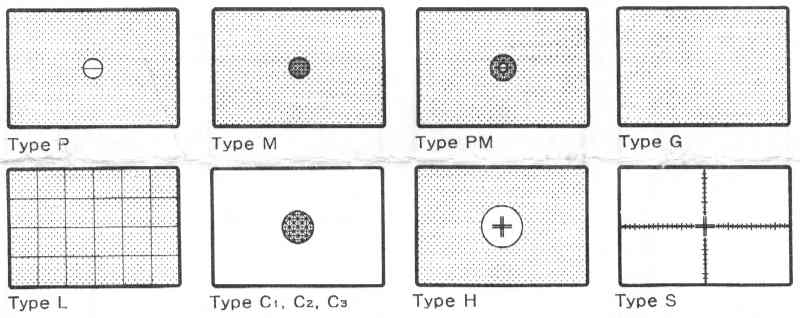
-
P -- Horizontal split for general photography (this was the screen that the
camera was sold with)
-
PM -- Horizontal split with microprism collar for general photography
-
M -- microprism spot for general photography
-
G -- matte field only for general photography
-
L -- matte field with grid for architectural photography
-
S -- horizontal and vertical measuring scales for macro-, micro-, and
astrophotography
-
H -- clear spot with engraved double cross for macro-, micro-, and
astrophotography
-
C1 -- extra bright screen for general photography with specific lenses
-
C2 -- extra bright screen for general photography with specific lenses
-
C3 -- extra bright screen for general photography with specific lenses
-
AP -- Diagonally-angled split with microprism collar for general photography
Plus, the XK had all the other bells and whistles available at the time --
mirror lock-up, DOF button, battery check, self-timer, and more. A
completely new, titanium shutter was used, and the camera had a Sensi-switch
which turns on the camera effortlessly -- just by picking up the camera.
More than twenty-five years later, this camera has more features than
most new SLR cameras. For a comparative look at the major features
of the XK models, check out
MINMAN's SLR table
-- the world's most complete!
This was the first Minolta SLR to sport an electronic shutter. The
good news about an electronic shutter is that is can provide speeds between
the numbered speeds -- in automatic mode, anyway. So if the exposure
calls for 1/751 of a second, that's what you get. Not 1/500 or 1/1,000.
Unfortunately, since the shutter is electronic, it is dependent on the battery,
and if the battery dies, you cannot take pictures -- so you better carry
a spare! This is why some people prefer the older, battery-free cameras,
or at least carry a battery-free camera as a backup. The XK with work
on B and X without a battery. It will help in an emergency, but it's
not too convenient.
There were actually six versions of the XK, not including the
XK Motor, depending on when and where you were.
-
XK (model a) -- 1972

Sold in the North American market. This model can be distinguished
by the ASA/DIN chart on the film door.
-
XM (model a) -- 1972
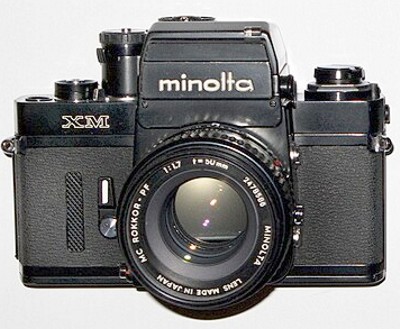
Sold in the European market. All of the camera features are the same.
-
X-1 (model a) -- 1972
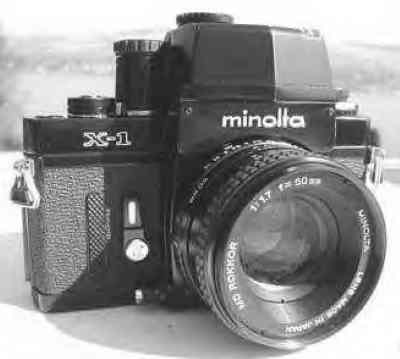
Sold in the Japanese market. All of the camera features are the same.
-
XK (model b) -- 1976

In 1976, Minolta produced a new model of the XK -- the XK
Motor. At the same time they made some modifications to the original
XK. The obvious difference is that they replaced the ASA/DIN chart
on the film door with the film-tab holder of the XK
Motor. In addition, there were some internal changes made to the
electronics, and the old-style film take-up reel from the SR and SRT cameras
was replaced by a new-style take-up reel seen on all of the later X cameras.
The new-style take-up reel was less likely to snap the film leader,
but many people find it much more difficult to use. Last, but not least,
the original AE head was no longer manufacturered, so the XK (model b) was
sold with the AE-S head.
The AE-S head was different in many ways (see above). First, it had
silicon cells instead of CDS cells so it was more sensitive in low-light
situations and reacted much faster to changes in light. It no longer
had the CLC metering system and used a basic center-weighted approach. In
addition, the display was changed. LED's replaced the needle readouts
in the AE head, but since the LED scale only displays the metered speed,
a new window was added to display the set shutter speed. Actually,
there were two shutter speed scales. Since the available speeds on
the XK are so wide, all of the speeds would not comfortably fit on a single
scale. Plus, Minolta engineers realized that under low-light conditions,
it can be impossible to read the shutter speed number (a problem in the later
XD and XG cameras). They devised a clever alternative. At speeds
less that 1/30, a button is pressed on the AE-S head and the LED scale is
replaced with the metered speed in LCD format -- easy to read in the darkest
light. For low-light shooting, the AE-S head is the undisputed champ.
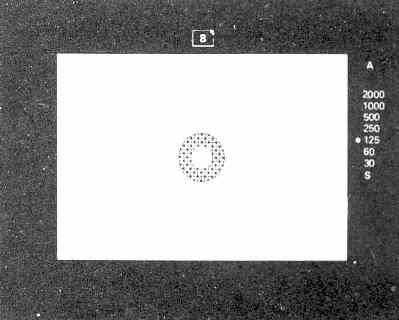
Sold in the North American market.
-
XM (model b) -- 1976

Sold in the European market. All of the camera features are the same.
-
X-1 (model b) -- 1976

Sold in the Japanese market. All of the camera features are the same.
-
XK (model r) -- 1978
Ritz Camera negotiated with Minolta to create a special version of the XK,
hence the "model r" designation. The obvious difference is that the body
has a notched, rubberized covering instead of the standard leatherette.
The covering is similar in appearance to that used on the focusing
rings of the Rokkor-X lenses. Some people love the waffle-covering because
it matches the lens appearance so well. Others find it less comfortable --
even irritating -- to hold when compared to the standard leaterette. All
of the camera features are the same. The Minolta
SRT201 was also produced in a "model r".
Minolta didn't just add a new camera with the XK. At the same time,
they decided to update and upgrade their complete line of MC
Rokkor lenses. The MC Rokkor-X line of lenses
was born. In fact, the "X" in "Rokkor-X" comes from the new X-series
of cameras that the XK initiated. Not only were new focal lengths added,
but lenses now had multi-coated optics, as well as better lens cosmetics.
For example, the aperture ring was changed from chrome with black numbers
to black with white numbers. Minolta engineers felt that these white numbers
show up better in the viewfinder readouts of f-stops -- a new feature which
first appeared with the Minolta XK. In addition, the focusing ring
on these lenses was now covered with a more comfortable, reliable, non-slip,
rubber waffling -- instead of the more slippery metal grooves of the earlier
lenses.
The XK was not the first Minolta SLR with automatic exposure control, as
many other sources list it. That designation went to the Minolta
ER of 1961. But the XK was the first Minolta SLR
with TTL metering AND auto-expousre control. The XK sold very well, despite
its high price-tag. But Minolta realized that the XK missed the mark.
Many professionals stayed away because the XK lacked a motor-drive option.
So Minolta decided to produce a motorized version -- the
XK Motor -- a few years later. Still, the
XK was designed for the high-end, professional market and Minolta realized
that it needed to produce a less expensive, auto-exposure 35mm SLR camera
targeting the mass-market. Other companies had already done it, like
the Canon EF, the Pentax ES and the Nikkormat EL, all from 1972. Minolta
quickly re-adjusted their sights and produced the amazing
XE-7 in 1974. Better late than never, I suppose.
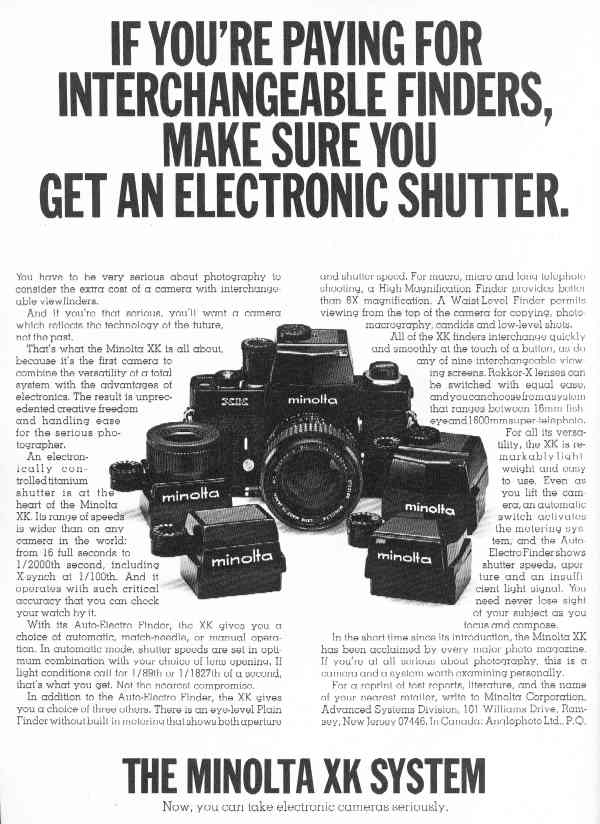
RETURN TO THE MANUAL
MINOLTA HOME PAGE
We didin't want to do this, but since other websites have been stealing our
stuff, we have no alternative but to state:
COPYRIGHT@1995-2023 by
Joe McGloin.
All Rights Reserved. The material on this website is protected by US Federal
copyright laws. It cannot be copied or used in any manner without specific
approval from the owner











